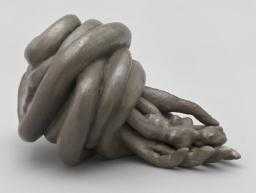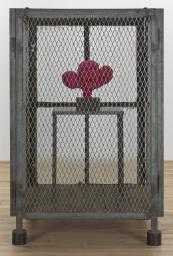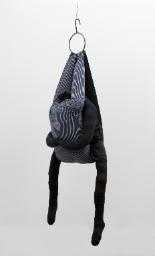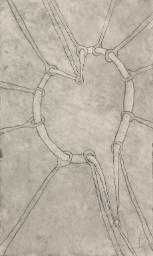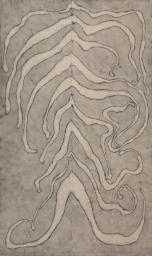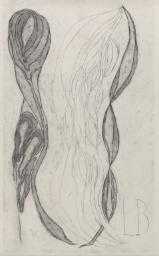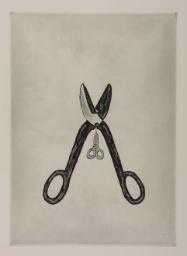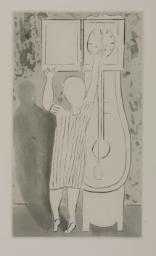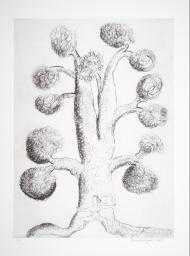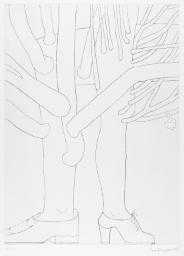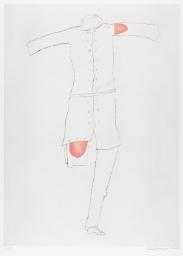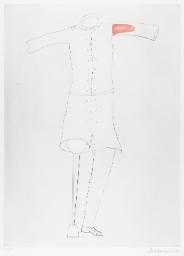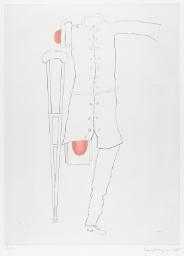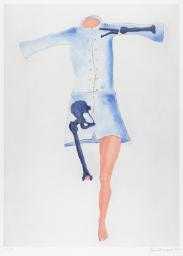
Not on display
- Artist
- Louise Bourgeois 1911–2010
- Medium
- Fabric, hanging piece
- Dimensions
- Unconfirmed: 2032 × 1066 × 762 mm, 15kg
- Collection
- ARTIST ROOMS
Tate and National Galleries of Scotland. Lent by Artist Rooms Foundation 2011
On long term loan - Reference
- AL00229
Summary
Single II is a hanging fabric sculpture, which depicts a headless figure. The sculpture is made from various pieces of black cotton and synthetic material, which has been sewn together and stuffed. The piece is suspended at the navel from a steel cable, causing the figure to arch backwards toward the floor. The figure’s extremities are not realised in detail, with only the suggestion of hands and feet. Single II formed part of an installation displayed in the bell tower of St Pancras Church in London for the exhibition ‘The Visible and the Invisible’ in 1996. Bourgeois made four figurative stuffed fabric sculptures for this piece: Single I 1996, Single II 1996, Couple I 1996 (Tate AL00344) and Couple II 1996. All of the sculptures were hung from the bell tower except Couple II, which was displayed nearby on the floor.
Curator Lucy Askew highlights the importance of the Single and Couple works being shown together: ‘the sculptures were either hung from the ceiling or laid horizontally, the idea of erotic dependency [was] shown … with its opposite state of isolation.’ (Askew and d’Offay 2013, p.83.) Whether in a pair or alone, all the figures in the composition suggested vulnerability, particularly those left hanging in mid-air. Bourgeois has commented on the melancholic and violent undertones of the corpse-like figures in this piece in relation to the colour black: ‘Black is sad. The colour of mourning. The headless figures are wishful thinking on my part. Black is the colour of resented authority’ (quoted in Askew and d’Offay 2013, p.83).
Askew also notes the similarity between the arching pose of the hanging figure in Single II and the figures in other Bourgeois works such as Arch of Hysteria 1993 (reproduced in Morris 2007, p.43) and Triptych for the Red Rooms 1994 (Tate AL00349). Bourgeois often uses the arch as visual shorthand for the figure of the hysteric, given that the condition was associated with dramatic bodily contortion. Historically hysteria was thought to affect only women and to derive from the uterus, but the curator Marie-Laure Bernadac has argued that, countering traditional psychoanalytic theory, Bourgeois did not see hysteria as exclusively feminine. This may explain the gender ambivalence of the figure in Single II and why male figures appear in both Arch of Hysteria and Triptych for the Red Rooms. Bernadac also argues that the artist did not see hysteria as an entirely negative or painful experience, she writes:
Her arch – the mounting of tension and the release of tension – is sexual. It is a substitute for orgasm, with no access to sex. She creates her own world and is very happy. Nowhere is it written that a person in these states is suffering. She functions in a self-made cell, where the rules of unhappiness or stress are unknown to us.
(Quoted in Morris 2007, p.158.)
The ambiguous gender of the hanging figure, then, could be seen as Bourgeois’s attempt to divorce the association of hysteria from the gendered body. Likewise the suspension of the figure above ground, neither fully of the air nor of the earth, suggests another in-between state. On the notion of the hanging figure, a recurring conceit in Bourgeois’s work, the artist has said: ‘Horizontality is a desire to give up, to sleep. Verticality is an attempt to escape. Hanging and floating are states of ambivalence.’ (Quoted in Askew and d’Offay 2013, p.48.)
Further reading
Mignon Nixon, Fantastic Reality: Louise Bourgeois and a Story of Modern Art, Cambridge, Massachusetts, and London 2005.
Frances Morris (ed.), Louise Bourgeois, exhibition catalogue, Tate Modern, London 2007, p.90.
Lucy Askew and Anthony d’Offay, Louise Bourgeois: A Woman Without Secrets, exhibition catalogue, National Galleries of Scotland, Edinburgh 2013, p.83, reproduced p.49.
Allan Madden
The University of Edinburgh
January 2015
The University of Edinburgh is a research partner of ARTIST ROOMS.
Does this text contain inaccurate information or language that you feel we should improve or change? We would like to hear from you.
Display caption
Bourgeois produced a large series of soft sculptures in her later years, making use of textiles and old clothing that she had kept for decades. This headless suspended figure made of stuffed fabric is posed in the ‘arch of hysteria’, a position expressing an extreme state of tension and pain documented by the nineteenth century French neurologist Jean-Martin Charcot.
Gallery label, October 2016
Does this text contain inaccurate information or language that you feel we should improve or change? We would like to hear from you.
Explore
- abstraction(8,615)
-
- from recognisable sources(3,634)
-
- figure(2,270)
- formal qualities(12,454)
-
- suspension(41)
- decapitated(25)
You might like
-
Louise Bourgeois Nature Study
1986 -
Louise Bourgeois Cell XIV (Portrait)
2000 -
Louise Bourgeois Couple I
1996 -
Louise Bourgeois The Stretch
2006 -
Louise Bourgeois Are You In Orbit? (#1)
2007 -
Louise Bourgeois The Unfolding
2007 -
Louise Bourgeois Scissors
1994 -
Louise Bourgeois Woman and Clock
1994 -
Louise Bourgeois Woman with Suitcase
1994 -
Louise Bourgeois Tree with Woman
1998 -
Louise Bourgeois Tree with Shoes
1998 -
Louise Bourgeois Amputee
1998 -
Louise Bourgeois Amputee with Peg Leg
1998 -
Louise Bourgeois Amputee with Crutch
1998 -
Louise Bourgeois Blue Dress
1998

